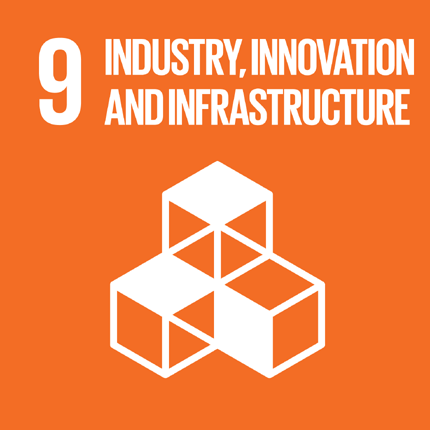sdg9
SUSTAINABLE DEVELOPMENT GOAL 9
Build resilient infrastructure, promote inclusive and sustainable industrialization and foster innovation
Progress of goal 9
- Goal 9 encompasses three important aspects of sustainable development: infrastructure, industrialization and innovation. Infrastructure provides the basic physical systems and structures essential to the operation of a society or enterprise. Industrialization drives economic growth, creates job opportunities and thereby reduces income poverty. Innovation advances the technological capabilities of industrial sectors and prompts the development of new skills.
- An important component of physical infrastructure is air shipping and air travel. In 2014, 45 per cent of all air passengers originated from developing regions; 55 per cent originated from developed regions. However, in the least developed countries, landlocked developing countries and small island developing States, air passenger volume was extremely low, making up only 0.8 per cent, 0.8 per cent and 1.4 per cent, respectively, of the global total. Similar patterns are found for freight volumes in air transit: the least developed countries, landlocked developing countries and small island developing States made up only 1.1 per cent, 0.9 per cent and 2.6 per cent of the global total, respectively, in 2014.
- Manufacturing is a foundation of economic development, employment and social stability. In 2015, the share of manufacturing value added in terms of GDP of developed regions was estimated at 13 per cent, a decrease over the past decade owing largely to the increasing role of services in developed regions. In contrast, the share of manufacturing value added in GDP remained relatively stagnant for developing regions, increasing marginally from 19 per cent in 2005 to 21 per cent in 2015. Those values hide substantial differences, with manufacturing value added contributing over 31 per cent to GDP in Eastern Asia and 10 per cent or less in both sub-Saharan Africa and Oceania. The least developed countries face particular challenges in industrializing. Although those countries represent 13 per cent of the global population, they contribute less than 1 per cent of global manufacturing value added. Worldwide, about 500 million people are employed in manufacturing. While manufacturing job numbers have fallen in industrialized countries, they have steadily increased in developing countries. In the least developed countries, agricultural and traditional sectors remain the main sources of employment.
- In developing countries, small-scale industries accounted for an estimated 15 per cent to 20 per cent of value added and 25 per cent to 30 per cent of total industrial employment in 2015. However, access to financial services in those countries remains a problem. Globally, the credit gap for small and medium enterprises (defined as having between 5 and 99 employees) was estimated at $3.2 trillion to $3.9 trillion in 2012. In emerging markets, between 45 per cent and 55 per cent of all small and medium enterprises are unserved or underserved by financial services.
- As the structure of world economies shifts to less energy-intensive industries and countries implement policies for enhanced energy efficiency, almost all regions have shown a reduction in carbon intensity of GDP. Global carbon dioxide emissions per unit of value added showed a steady decline between 1990 and 2013, a decrease of about 30 per cent.
- Innovation and the creation of new and more sustainable industries are spurred by investments in research and development. Global expenditure on research and development as a proportion of GDP stood at 1.7 per cent in 2013. However, this figure masks wide disparities. expenditure on research and development was 2.4 per cent of GDP for developed regions, 1.2 per cent for developing regions, and below 0.3 per cent for the least developed countries and landlocked developing countries. The number of researchers per 1 million inhabitants showed a similar pattern. While the global average was 1,083 researchers per 1 million inhabitants, the ratio ranged from 65 per 1 million in the least developed countries to 3,641 per 1 million in developed regions.
- Total official flows for economic infrastructure in developing regions reached $59.5 billion in 2014. The main sectors receiving assistance were transport and energy.
- Infrastructure and economic development also rely on information and communications technology. Mobile cellular services have spread rapidly around the world, allowing people in previously unconnected areas to join the global information society. By 2015, the percentage of the population living in areas covered by mobile broadband networks stood at 69 per cent globally. In rural areas, the share was only 29 per cent.
Source: United Nations, Department of Economic and Social Affairs, SUSTAINABLE DEVELOPMENT KNOWLEDGE PLATFORM
The National Indicators for Sustainable Development Goal 9 are:
- Passenger and freight volumes, by mode of transport
- Manufacturing value added as a proportion of GDP and per capita (%)
- Manufacturing employment as a proportion of total employment (%)
- Proportion of small-scale industries in total industry value added (%)
- CO2 emission per unit of value added (in tonne)
- Research and development expenditure as a proportion of GDP (%)
- Gross domestic expenditure on R&D by sector - % of GDP
- R&D personnel by sector - % of active population
- Share of busses and trains in total passenger transport (%)
- Share of rail in total freight transport (%)
All available data in .xls file:
· Industry, innovation and infrastructure
Last Updated: 12/5/2025
EU SDG indicator set
To measure SDG achievement in an EU context, an EU SDG indicator set was developed under the leadership of Eurostat. The purpose of this set, which is structured along the 17 global Sustainable Development Goals, is to monitor progress towards the SDGs at the European level.
- For the complete set of indicators available in the Eurostat database, click here.
- To compare Greece’s progress on specific indicators for each Sustainable Development Goal, click here [data visualisation].

